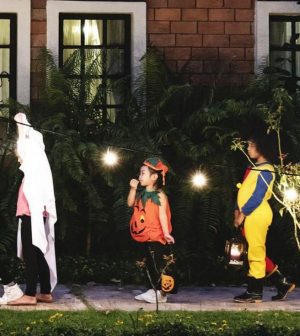- Navigating Your Midlife Crisis: Embracing New Possibilities
- City Raccoons Showing Signs of Domestication
- Mapping the Exposome: Science Broadens Focus to Environmental Disease Triggers
- One Week Less on Social Media Linked to Better Mental Health
- Your Brain Changes in Stages as You Age, Study Finds
- Some Suicide Victims Show No Typical Warning Signs, Study Finds
- ByHeart Formula Faces Lawsuits After Babies Sickened With Botulism
- Switch to Vegan Diet Could Cut Your Greenhouse Gas Emissions in Half
- Regular Bedtime Does Wonders for Blood Pressure
- Dining Alone Could Mean Worse Nutrition for Seniors
Hidden Poisons Can Make Trick-or-Treating Truly Scary

Accidental poisonings on Halloween can turn a night of fun into one that’s truly scary.
The following poison prevention tips — from the Nebraska Regional Poison Center — can help your little ones stay safe:
The liquid in lighted glow sticks can sting or burn if it gets into the eyes or mouth. Know that glow sticks are soft and can easily break open if children put them in their mouths. If this happens, rinse with water and call the national poison control center (1-800-222-1222).
Check your children’s goodies when they return from trick-or-treating. Marijuana edibles come in many shapes and sizes and can have names and packaging similar to traditional candies.
Throw out any homemade treats or anything that’s not in its original wrapper, unless you know the person who gave it to your child.
When face painting or using makeup, select nontoxic face paint. Be sure to remove all makeup and fluorescent hair sprays before bedtime.
Serving punch containing dry ice isn’t dangerous if the ice isn’t swallowed in its solid form. Small pieces should not be put in individual glasses. Frostbite can occur if dry ice touches the skin or mouth.
Chocolate and xylitol (the artificial sweetener in sugar-free candy and gum) are very poisonous to dogs. Store all candy up and out of reach of dogs and other pets.
In terms of general safety, the University of Nebraska Medical Center says costumes should be warm, well-fitting and nonflammable. Consider applying reflective tape to costumes that will be worn after dark.
If a child wears a mask, it should permit adequate vision and be removed when crossing streets. Children should be accompanied by an adult when trick-or-treating, and have a flashlight if out when it’s dark.
More information
The American Academy of Pediatrics has more Halloween health and safety tips.
SOURCE: Nebraska Regional Poison Center, University of Nebraska Medical Center, news release, Oct. 20, 2021
Source: HealthDay
Copyright © 2025 HealthDay. All rights reserved.










